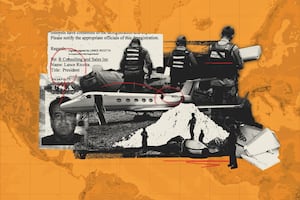Más Información

En SLP nunca ha existido una gobernadora y ahora hay una posibilidad real que así sea, asegura Ricardo Gallardo tras aprobación de "Ley Esposa"

Morena analiza disminución de pluris y elección popular de consejeros del INE: Monreal; serán revisadas en la reforma electoral, dice

Rastro de jets vinculados al narcotráfico lleva a un vendedor en California… y a un punto ciego de la regulación aérea en Estados Unidos

Secretaría Anticorrupción sanciona a dos empresas por buscar contratos con información falsa; imponen multa de miles de pesos

Banxico se despide de 2025 con otro recorte a la tasa de interés; queda en 7% por ajuste de 25 puntos base
From lice in rats on board of vessels to viruses in planes, that is how the history of epidemics could be summarized in what is known today as Mexico , although that history has its antecedents in the pre-Columbian world.
In over five centuries of epidemics, the territories of what is nowadays Mexico City and the rest of the country have faced serious , long , and deadly epidemics , some because of viruses , others because of bacterias , and some even as the result of hunger . Almost all of them reached Mexico through invasions .
The second semester of 2020 will mark the 500 anniversary of one of the most deadly pandemic in Mexico: smallpox . But the worst by far was the 1576 hueycocoliztli epidemic that almost eliminated the population.
Recommended: The fatal results of the 1918 Spanish flu pandemic in Mexico
Dr. Carlos Viesca Treviño
, an academic of the Department of History and Philosophy of Medicine of the Medicine Faculty of the National Autonomous University of Mexico (UNAM) , who has studied diseases and their history, and who along with researcher Elva Malvido wrote about the 1576 epidemic, talked about their characteristics and memories.
The Conquest
“There were diseases in Mexico but there was a balance between the environment and the existing cultures. When the Spanish arrived – and this is valid for the whole 16th century and for the colonization in Asia and the Pacific – the world became one and thus came pathogens from the Old World to the New World, and others went from the New World to the Old World,” says Viesca, author of books like Medicina prehisopánica de México (Mexico’s Pre-Hispanic Medicine).
Murine typhus
was one of the epidemics in Mexico before the arrival of the Spanish. Approximately in 1508 , there was a typhus epidemic but even before that, some sources assert that epidemics ended with Tula in the 12th century.
Viesca describes that with the Conquest , the change of hygiene habits promoted the presence of diseases. “While indigenous people used to bathe several times per day and did not wear so many clothes, with the Europeans they had to cover and dress, and clothes had lice that gave them typhus and hence, there were more diseases. The Catholic church even banned temazcal because it was deemed sinful, but it would have prevented many problems.”

The name designated for these serious diseases existed before the first epidemic brought by the Spanish. They were called cocoliztli , which means “the disease we catch” and then a second word was added for further details or characteristics, he explains.
Smallpox
was the first great epidemic in 1520 . “It didn’t reach pandemic proportions because it did not get to other parts of the world but it did reach all of the American continent little by little.”
According to chroniclers, Francisco de Eguía , who had been a slave to Pánfilo Narváez , and who came from northern Spain , spread the disease; nowadays we would call him the patient zero .

“It didn’t hurt the Spanish too much, for they already knew smallpox , but when it arrived in Tenochtitlan , there was a terrible epidemic during the second semester of 1520 . A lot of people died, including Cuitláhuac .” This epidemic attacked many adults and youths. There are different figures: some talk about 300,000 victims, others mention 40% of the population . The researcher says that historians agree that it was key for Hernán Cortés to achieve colonization.
“We know, by Tlaxcala’s chronicler Muñoz Camargo , that when people began to have the rash and felt discomfort, they bathed in the river and, obviously, all those who bathed in the river got infected. The river near Tlaxcala was called river Zahuatl , which means river of pimples ; smallpox was called hueyzahuatl cocoliztli .”
Recommended: Looking back at Mexico's H1N1 virus pandemic
Smallpox went on for centuries with epidemic outbreaks approximately every 25 years until the inoculation process took place between the 18th and 19th centuries and the vaccine was developed.
After smallpox, the second epidemic was in 1531 : Measles , which also arrived with the Conquest, and that killed mainly children , according to Dr. Viesca. They called it tepitonzahuatl .
14 years later, in 1545 , the territory suffered another epidemic, which they called hueycocoliztli matlazahuatl . Viesca thinks it was epidemic typhus from Europe. “They said black rats ran from the coast to the valleys and that is why I think it was typhus: Black rats come in ships; typhus is transmitted from lice in rats; rats don’t die, they are just the vehicle. This matlazahuatl also kills a lot of people and expands from Mexico’s coast to the valley and then the periphery.”
From this epidemic, some measures were implemented, such as putting lime on corpses. One of the infected was Fray Bernardino de Sahagún , who survived.
In the next years, there were smallpox outbreaks that were not epidemics but endemics ; however, “peace” lasted until 1576 .
“The 1576 epidemic was the worst of the 16th century . It was only called hueycocoliztli , they didn’t add a last name because they didn’t know what it was. Recently, German researchers said it was typhoid because they found its genome in some remains from those times in Oaxaca. It seems to me barbaric for it killed over 1,200,000 people in a month and there is no typhoid that kills that number of people. It had been said that it had been malaria , then that was epidemic hepatitis , but not. Elsa Malvido and I think it was the bubonic plague because in 1575 and 1576 there was a very serious epidemic in China that arrived in the Philippines, and even Venice and Europe. But studying geography, we found that first places it reached [in Mexico] had not been Acapulco, San Blas, Veracruz, or Yucatán and that it did not reach the Antilles, so we had to go back. Now, I think it was a hemorrhagic fever because back then, people began settling the mining areas in Durango and Zacatecas and because this fever was very well described by two doctors: Francisco Hernández, doctor to Felipe II, and Alonso López de Hinojosos.”
Recommended: Mexico's Conquest: the environmental impact
Dr. Viesca says that this epidemic was terrible and spread throughout Mexico. “Between August and late 1576, it killed over a million people in central Mexico, where four out of every five persons died.”
Malaria
, which arrived with slaves, was another epidemic in the 16th century . The population that suffered it the most was the one on the coast. Millions died in the century of the Conquest. It is said that from Durango to Guatemala, there used to be between 25 and 30 million people before the Spanish but “by 1590 , there were one million .”
The opposite effect also took place: America exported diseases . Viesca quotes, in that case, a kind of syphilis . “There was already syphilis in Europe before the discovery of America, but Europeans got infected with another kind of syphilis, the American one, for which they had no defenses. There was a brutal syphilis epidemic in 1493 that reached Europe from the Antilles, not from Mexico. The first one to die was one of Columbus’s pilots.
New Spain and Independence
In 1736 , there was another serious typhus epidemic . There were also strong flu epidemics in 1710 and 1800 . “We can notice the flu every 100 years . The many flu viruses mutate and there are much more aggressive outbreaks , such as the H1N1 , it was the same from the 1918 Spanish flu .” Viesca describes that also, amid the Independence fight, near 1813 , there was an epidemic in Cuautla . “There are several books about it; it has been said it was typhus or flu , that it struck the Spanish but not José María Morelos’s troops, who came from the coast.”

A cholera pandemic, not an epidemic, took place in 1833 . It began in India in 1825, arrived in Europe in 1829, and in Mexico until 1833. “There were approximately 30,000 deceases in the Valley of Mexico.”
There was another epidemic during that century, but this time it was diphtheria . It arrived in Mexico with the French invasion . By the end of that century, as a measure against epidemics, doctor Eduardo Liceaga , president of Mexico’s Supreme Council of Salubrity, created lazarettos , quarantine stations to isolate infected patients, where cases of yellow fever and bubonic plague were confined.

“The country got rid of yellow fever by 1911 through quarantines and by drying ponds ; although it came back with the American invasion in Tampico (1914). In Mexico City, there was never a wall as lazarettos, but there were in Veracruz, Tampico, Progreso, and Mazatlán.”
Recommended: COVID-19: The coronavirus epidemic could last at least 3 months in Mexico
Carlos Viesca has also written about an epidemic in Mexico in 1914 that was not because of a virus or a bacteria but due to hunger . “It was a very particular epidemic, of weird swellings , because of hunger, not a germ; back then, food didn’t reach Mexico City. Poor people had to eat bark, branches; they became full of fluid due to the lack of protein. This epidemic and that of pellagra in Africa are not contagious but they seem to be because the whole population experienced it.”
Soon after, Mexico was struck by the 1918 Spanish flu pandemic which caused the death of 50 million people in the world and between 300,000 and 500,000 in our country.
Polio
struck Mexico during the 1950s . Then, in the 1980s , HIV ; cholera and dengue in the 1990s ; however, these cases are mostly epidemics.
The most recent epidemic in the country took place in 2009 . “The H1N1 , the same as the Spanish flu; luckily it was not as harmful as it was expected – it was very well controlled. A decade later, we are facing COVID-19 , “We have gone from a history of lice in rats traveling by boat, to virus traveling by plane.”
Recommended: COVID-19: Myths vs Facts
mp
Noticias según tus intereses
[Publicidad]
[Publicidad]








